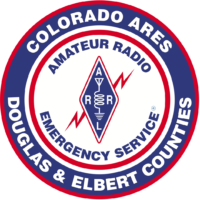ARRL’s Simulated Emergency Test (SET) was October 7 – 8, 2023. This nationwide exercise is the chance to test personal emergency-operating skills and the readiness of communications equipment and accessories in a simulated emergency-like deployment. The ARRL’s Amateur Radio Emergency Service ® (ARES®), the National Traffic System (NTS), the Radio Amateur Civil Emergency Service (RACES), SKYWARN, Community Emergency Response Team (CERT), Salvation Army Team Emergency Radio Network (SATERN), and other allied groups and public-service oriented radio amateurs are among those who were eligible to participate in the simulated exercise and to practice emergency operation plans, nets and procedures.
This year the Colorado ARES Section organized a coordinated communications exercise for Saturday Oct 7th for all Colorado regions and districts. The scenario centered around a derecho, which is a widespread, long-lived, straight-line windstorm that is associated with a fast moving group of severe thunderstorms. The simulated emergency focused on a derecho that formed and traveled across the width of Colorado from north to south. Wind speeds were in excess of 140 mph on the plains with higher wind speeds occurring in the high country. The winds took out power lines, cell towers, and many microwave links as the leading edge of the storm progressed. As a result, cell communications were taken out, the internet was down, and power was out. Local areas were cut off due to trees blocking the roads and statewide communications were totally disrupted. With both preferred and alternate communication pathways eliminated, the state and local emergency response required the use of ARES ham radio to fill the gaps.
Seventeen R1D5 members participated in this year’s SET. Eight members paired up and operated on site at the Douglas County EOC, Elbert County EOC, Advent Health Parker hospital, and Sky Ridge Medical Center. The other nine members participated from home. Participants received an ICS 205, 205A, and 217 ahead of time via CVM (Colorado Volunteer Mobilizer). Throughout the SET members received injects describing the position and intensity of the storm as well as the subsequent damage and destruction. R1D5 members stayed in contact and passed messages via analog voice, DMR, and Winlink (email over radio). Additionally, some members also monitored and passed messages on a 60M net setup by the state. Overall R1D5 performed well per our plans, preparations, and responses to this simulated communications emergency.
By the way “Exercise, Exercise, Exercise” is a phrase that is said and repeated many, many times throughout the SET so that anyone listening knows this activity is just a drill and not a real emergency.









